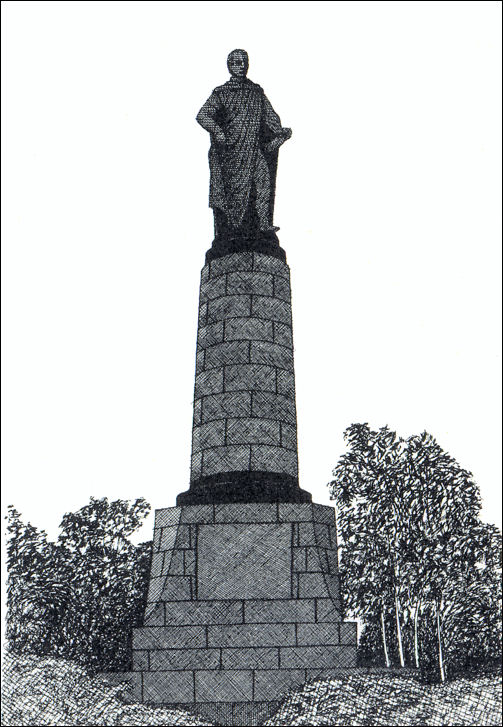|
|
|
![]() back to "The Grand Tour" index
back to "The Grand Tour" index
Neville Malkin's "Grand Tour" of the Potteries
buildings South of the Potteries
![]()
![]()
![]()
next: riding school,
Trentham Hall
previous: Barlaston Hall
contents: index of
buildings south of the Potteries
|
No 10 - Sutherland Monument
[Reproduced by permission
of the
|

The Sutherland Monument,
Trentham Estate
pen drawing by Neville Malkin - June 1975
|
"In the southern extremity of Trentham Estate, and, in sharp contrast to its natural surroundings, stands the monument to the 1st Duke of Sutherland. This colossal statue, designed by Winks and sculptured by Chantrey, surmounts a plain column of stone on a tiered pedestal. Set into the base of the column is a weather-worn inscription that gives some indication of the Duke's popularity. It reads:
The actual origin of the 1st Duke's title is a little complicated but the following brief account may shed some light: The 1st Duke's family name was Leveson-Gower and Trentham Hall was their ancestral home along with three other mansions and over a million acres of land. His wife-to-be, Countess Elizabeth, was the daughter of the 18th Earl of Sutherland, a completely separate family, whose possessions included Dunrobin Castle and the entire County of Sutherland. In 1771, at the age of 7, Elizabeth applied to the House of Lords for her late father's title; this application was granted and she became known as Countess Elizabeth of Sutherland and Baroness Strathnaver. In 1785, Countess Elizabeth, who was Britain's greatest heiress, married George Granville Leveson-Gower. Some 48 years later he was made a Duke in recognition of his political service and, as a compliment to his wife, chose as his title the name Sutherland; his wife, therefore, became known as Duchess-Countess. Eventually the two titles were brought together by their son, the 2nd Duke."
|
In the southern extremity of Trentham Estate, and, in sharp contrast to its natural surroundings, stands the monument to the 1st Duke of Sutherland.
Photo: © Les Singleton Feb 2007
photo: Public Monument and Sculpture Association National Recording Project
|
The monument was raised in 1834 at the instigation of the second Duke, a year after the first Duke's death. A wide range of possible monuments was put forward but it was Chantry, with whom Loch, the Duke's Chief Agent, had been in touch, who recommended Barry for the design of the monument. The first Duke of Sutherland, George Grenville, succeeded his father as Marquess of Stafford in 1803. In 1785, he had acquired extensive lands in northern Scotland through his marriage to Countess Elizabeth of Sutherland. Whilst his achievements in Staffordshire were many, it is through his involvement with his Scottish lands that he achieved greatest notoriety. Around 1810, convinced that the interior of Sutherland could not support subsistence farming in the longer term, he initiated the most notorious of the Highland Clearances. He set about resettling thousands of families along the coast, making way for sheep. The evictions were carried out ruthlessly by the Duke's agents, who burned the houses and forced many out of the area. It is widely believed that he shoulders much of the blame for this event and the subsequent destruction of the highland way of life. In Scotland, he is remembered by a monument by a statue by Sir Francis Chantry outside Golspie. Although, like the Trentham Monument, it was built by public subscription, there were few subscribers from Sutherland and the Monument has since become the focus for nationalist hatred of the Duke of Sutherland (who only acquired this title in 1833 for this politcal services to the Liberal Party). The 1st Duke of Sutherland, George Grenville (d.1833) was a member of the Leveson-Gower family. In recent years the reputation of the Duke has been bought into question, in particular his connections with the slave trade, the poor working conditions of the mines he owned, and his involvement with the Highland Clearances. A letter to the local paper stated the people of Staffordshire should, 'Keep the monument, but don't hold the Duke in high regard.' |
next: riding school, Trentham Hall
previous: Barlaston Hall
contents: index of buildings south of the Potteries
back to "The Grand Tour" index